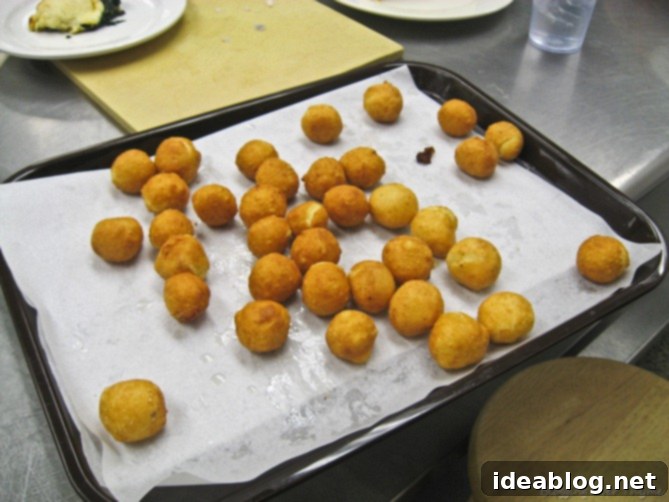Culinary Journeys: Mastering Classic Techniques and Innovative Flavors
Wednesday in the culinary lab was a vibrant tapestry woven with both foundational techniques and exciting new culinary explorations. What began on Tuesday afternoon with the preparation of our whole chickens ultimately culminated in a delicious and insightful learning experience. Our primary focus was on achieving exceptional moisture and flavor, which led us deep into the fascinating world of brining.
The Art and Science of Brining Whole Chickens
The brining process, a technique I had never personally attempted before, is designed to significantly enhance the moisture and tenderness of meat. It works on the principle of osmosis and diffusion, where the salt solution penetrates the meat, causing the muscle proteins to denature and unravel. This allows the meat to retain more moisture during cooking, resulting in a remarkably succulent and flavorful outcome. Our basic brine was a simple yet effective concoction, consisting of approximately a gallon of water, 1 to 1.5 cups of salt – a crucial component for the osmotic process – along with aromatic additions like pickling spice, sliced onions, and crushed garlic. These aromatics not only infuse the chicken with subtle background flavors but also contribute to the overall complexity of the final dish. While we brined our chickens overnight for maximum effect, a good general rule of thumb is to allow about an hour of brining time per pound of meat, ensuring proper saturation without over-salting.
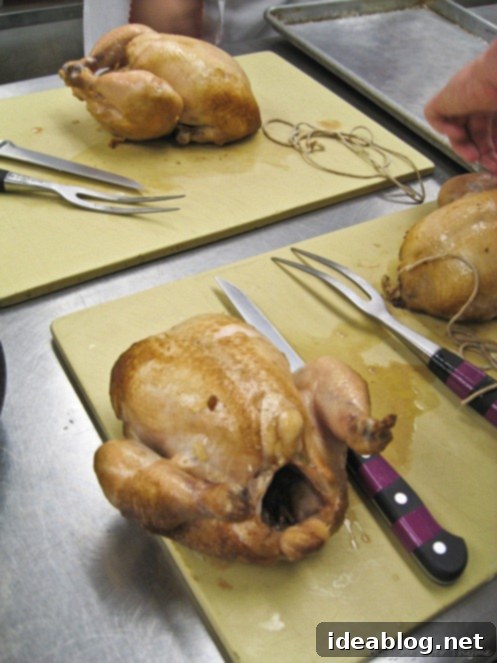
The results of our brining experiment were genuinely impressive. The chicken emerged incredibly flavorful and, true to the promise of brining, wonderfully moist. The cooking process itself mirrored some of the fundamental techniques we learned earlier in the semester, specifically during our third week of school when we first tackled whole chicken preparation. After removing the chicken from the brine, the first critical step was to dry it thoroughly. This isn’t just about neatness; a dry surface is essential for achieving a perfect sear. We then proceeded to sear the sides of the chicken – intentionally avoiding the breasts to prevent overcooking – in a hot sauté pan. This searing creates a beautiful, caramelized crust through the Maillard reaction, locking in flavors and adding textural contrast. Once seared, the chicken was placed in the oven, nestled amongst a classic mirepoix of carrots, celery, and onions, to roast until perfectly tender. The mirepoix serves not only as a bed for the chicken but also as a fundamental flavor base for the accompanying sauce.
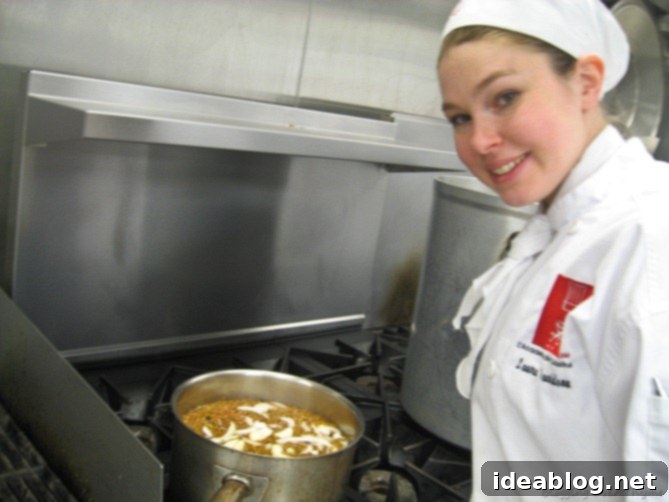
Just before service, the roasted chicken was skillfully carved. To elevate the dish further, we utilized the leftover bones from carving and the cooked mirepoix from the roasting pan to create a quick, flavorful jus. By deglazing the pan with chicken stock and simmering it with the bones and vegetables, we extracted every last bit of savory goodness, resulting in a rich, concentrated sauce that perfectly complemented the succulent chicken. This entire process, from brining to roasting and finally creating the jus, showcased a comprehensive understanding of chicken cookery and flavor development.
Introducing Pommes Dauphine: A French Potato Delicacy
To accompany our perfectly roasted chicken, we delved into another intriguing French classic: pommes dauphine. This dish is a delightful testament to the versatility of French culinary innovation, cleverly incorporating the delicate pâte à choux dough. The preparation involves creating a smooth, creamy mashed potato base, which is then combined with roughly equal parts of freshly made pâte à choux. Pâte à choux, a light pastry dough used for dishes like éclairs and gougères, lends an incredible airiness and crispness to the potato mixture. Once combined, the dough is gently formed into small, elegant balls – a process that requires a delicate touch – and then deep-fried until golden brown and irresistibly crispy on the outside, while remaining wonderfully light and fluffy within.
My initial thought, and one shared by many of my classmates, was that these were almost like a sophisticated French take on American hush puppies. While I wouldn’t consider myself a hush puppy connoisseur, the comparison highlighted the comfort and satisfying crunch of the pommes dauphine, albeit with a distinctly more refined texture and flavor profile. It was a fantastic example of how simple ingredients, when combined with expert technique, can be transformed into something truly special.
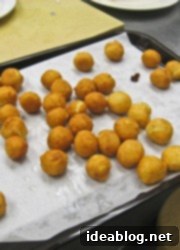
Quick and Flavorful: Chef Somchet’s Stir-fry
Adding a touch of Asian inspiration to our diverse menu, we also quickly assembled a simple yet incredibly flavorful stir-fry. Prepared in Chef Somchet’s signature style, which emphasizes fresh ingredients and vibrant flavors, this side dish featured crisp bok choy and napa cabbage. These leafy greens provided a wonderful texture and freshness, perfectly complemented by the pungent aromatics of finely minced garlic and grated ginger. A splash of savory oyster sauce tied all the flavors together, adding a hint of umami and sweetness. The beauty of a stir-fry lies in its speed and ability to deliver maximum flavor with minimal cooking time, showcasing the importance of proper ingredient preparation and high-heat cooking.
Elegant Appetizer: Soft-Boiled Eggs with Mornay and Spinach
For our appetizer course, we prepared an elegant dish featuring soft-boiled eggs served atop a bed of sautéed spinach, generously coated with a rich mornay sauce, and then gratineed to perfection in the oven. This dish, reminiscent of a classic Eggs Florentine, presented its own unique set of challenges. The most critical aspect was achieving the perfect soft-boiled egg: the whites needed to be fully set and firm, while the yolks had to remain utterly runny and luscious. This delicate balance typically requires cooking the eggs for a precise duration, usually between 4 to 5 minutes, depending on their size and initial temperature. It took us a few attempts to master this timing, illustrating the precision required in even seemingly simple culinary tasks.
Adding to the complexity, the eggs we used appeared to be exceptionally fresh, which paradoxically made them incredibly difficult to peel without damaging the delicate whites. Fresh eggs, having a tighter membrane, often adhere more stubbornly to the shell. This experience was a valuable lesson in adapting to ingredient variations. The mornay sauce itself was a luxurious creation, starting with a classic béchamel – one of the French mother sauces – which was then enriched with a generous amount of cheese, transforming it into a velvety, savory delight. After spooning the cheesy mornay over the eggs and spinach, the dish was briefly gratineed in the oven, creating a beautiful golden-brown crust that added another layer of texture and flavor. While perhaps richer than modern palates might typically prefer, the dish was undoubtedly more delicious than it might sound, a truly satisfying and decadent start to the meal. It was so substantial, in fact, that it could easily serve as a light meal on its own. I’m keen to explore possibilities for a more modern, lighter interpretation of this classic in the future.
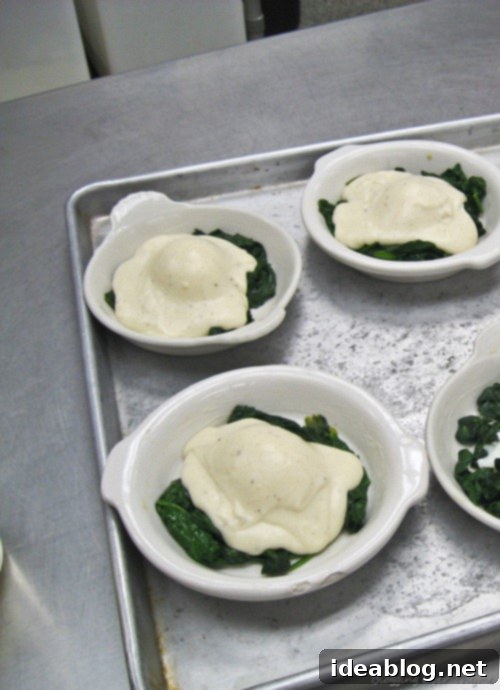
Delectable Dessert: White Chocolate, Orange, and Grand Marnier Cheesecake
No grand meal is complete without a memorable dessert, and ours was a delightful cheesecake that we had meticulously prepared the previous afternoon. This particular cheesecake was an unbaked variety, which means it relied on gelatin for its set texture rather than eggs, resulting in a lighter, almost mousse-like consistency. The flavor profile was exquisitely balanced, featuring the creamy sweetness of white chocolate, the bright, zesty notes of fresh orange zest, and a sophisticated hint of Grand Marnier, an orange-flavored liqueur. This combination created a harmonious blend of richness and refreshing citrus. Perhaps the most innovative aspect of this cheesecake was its crust: instead of a traditional biscuit or graham cracker base, we used a thin ring of roulade, or sponge cake. This choice significantly lightened the overall dessert, providing a delicate counterpoint to the creamy filling, making it a much airier experience compared to the denser cheesecakes I’ve encountered in the past.
Despite confessing to not typically being a “cheesecake person” – a recurring theme in my culinary preferences this week, it seems! – I found myself enjoying this particular creation far more than I had anticipated. Its unique texture and well-balanced flavors were truly impressive, challenging my preconceived notions about cheesecakes and showcasing the artistry involved in dessert innovation.
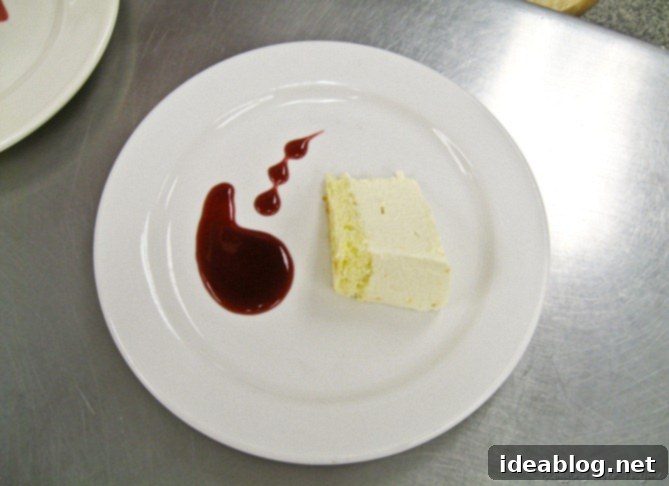
Academic Progress and Future Steps: Externship Insights
Beyond the delicious practical work, the afternoon brought some significant news regarding our academic journey. We finally received the results for our practical two written exam, which I was very pleased with, confirming my theoretical understanding of the techniques we’ve been practicing. Following this, I attended a concise review session where the primary focus shifted to the next exciting phase of our culinary education: our upcoming externship and Phase III of the program. This session provided initial details and guidance on what to expect as we transition from the classroom to real-world kitchen environments. Externships are a crucial component of culinary training, offering invaluable hands-on experience and professional exposure. I am incredibly excited about this next step and the opportunity to apply the skills and knowledge I’ve gained. As we learn more and the process gets underway, I will certainly share further details and insights into this pivotal stage of my culinary development.
Stay tuned for Thursday’s update, where I’ll share more about our ongoing culinary adventures and discoveries!
